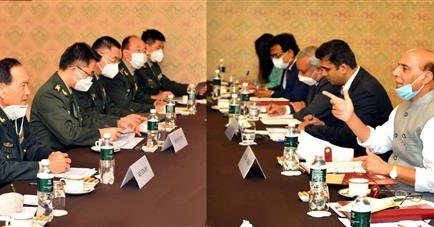The alarm has been buzzing in the Indian Political Diaspora regarding the gradual growth of China in bilateral trade. The latest report released by the General Administration of Customs in Beijing recorded a surge in trade exchanges between India and China by 8.4 percent, crossing $135 billion. India’s export to China declined by $10.62 billion - currently marked at $17.48 billion - as Chinese exports to India shoots up by 45 percent from $69.4 billion to $101.02 billion.
This trajectory has been continuing since 2004-2005 due to the excessive dominance of China in three key exports: pharmaceutical Ingredients, auto components, and large quantities of machinery. This dents the ‘Make in India’ policy initiative that was launched in 2014 and aimed to boost the domestic market while transforming the manufacturing sector. Goods coming from China occupied major factions of the Indian economy, including the smartphone industry, while the initiative aimed to establish India as a Global manufacturing alternative to China at International fora.
According to analysts, the boycott that has been a politically prevailing idea in the socio-political sphere in India fails to have a balancing approach that could have contributed to the reduction of the trade deficit as the needs of India and China supersedes such political rhetoric and the continuity of trade is beneficial for both nations.
India advocates for ‘Make in India’, which ended in failure due to taxation policy. Companies like Tesla who desired to explore the Indian market opted out, as well as ford motors, Harley Davidson and other companies. Taxation is a rational concern as simultaneously bureaucratic interventions too raised the question of the ability of multinational corporations to function without political influence. The case of the rift between Twitter and the Government of India revealed where political pressure silences dissent, WhatsApp pre-encryption user data collection policy under the New IT Act dissuades companies to visualize India as 21st Century China. The Public-Private Partnership initiative is exercised as a tool to transfer the burden of employment over individuals so government concern will reach a panacea.
Amid domestic chaos, China and India traded over a hundred billion dollars’ worth of goods and services, raising the question of whether the so-called boycott of China through the prohibition on software applications and temporary suspension of Chinese investment in India was merely a sophisticated delusion invoking nationalist spirit - whilst sitting on the lap of the Panda behind closed doors. This was not new as the Hallow initiative to counter China reiterated ample time. The Japan-India-African Partnership was the pioneer of tragedy where the Asia-Africa partnership never broke the surface.
Undertaking foreign relations, the ‘Belt and Road Initiative’ transcends the influence of China throughout the world, especially in the African region where participation from 27 countries has been recorded, contributing $79 billion. The Build Back Better world initiative of the West to undermine the BRI project possesses great advantages, as around $40 trillion are intended to be spent, from the Indian position it will drag India into the dilemma of geopolitics; therefore, uncertainty over it has delayed the process of opting into action.
The CPEC project in the aftermath of the Taliban regime arrival paved the way for China to be less concerned about the Western border, while the reluctance of the Indian government to commit to any concrete action put India under tremendous pressure, undermining national security and blurring any possibility of projecting itself as a global power, not just in the economy but also in defense and security.
The Bangladesh Prime Minister inaugurated a project under BRI, shedding light on the widespread anticipation that the Asian tiger had shifted his forest base a few miles ago and could be seen in The Greater Hinggan. China has given Duty-Free (DF) access to 97 percent of Bangladeshi products, which came into force on 1 July 2020 to resurrect the assumption, that India’s emphasis on manufacturing cheap domestic goods.
The February coup in Myanmar paved the way for the BRI project as the military junta in April sanctioned the project of a liquefied gas pipeline, enabling China to bypass the Malacca strait interconnecting with the Bay Bengal. The Sri Lanka case of the Hambantota Port jackpot is yet to be cashed in by China, who took it for lease for 99 years and advanced the treaties to install the surveillance ships with nuclear submarines there. The current Sri Lankan financial crisis builds such circumstances where China’s mammoth cash reserve will subdue the Rajapaksa regime to come to terms with China Xi Jinping’s helmsman.
The India Asia pacific strategy accommodates the maritime blockade as a realistic option against the aggression of China. As per the Diplomat, in 2016, around 80 percent of Chinese oil imports crossed the Malacca Strait. This puts China in a vulnerable position where India’s naval presence and the United States’ initiatives to attain a dominant role in the Asia Pacific put China’s security at risk. China vested its efforts and money to raise Pakistan to a level where it could present itself as a threat, exercising it to dissuade India to intervene in the Taiwan case by empowering Pakistan to intrude and raise the demand for Kashmir. The Russians closely monitored this dilemma ages ago; since then, Russia has built significant military ties with Pakistan, conducting military drills with Pakistan in 2016 despite India’s appeal to Russia in securing a boycott. In Feb 2021, four helicopters were traded off to Pakistan from Russia, whose Defense by Foreign Minister Lavrov stated, “Russia shares independent ties with Both India and Pakistan.” Combined with an ideological standpoint, India exercised its mammoth economy to influence neighbors as China successfully bid on it throughout the years. This indicates the 21th Century Helmsman General Secretary Xi Jinping steering the Chinese Titanic in the global ocean of geo-economics bending the adversaries and reaping the fruit of opportunity, through economic power and a visionary approach.


Follow the comments: |
|
